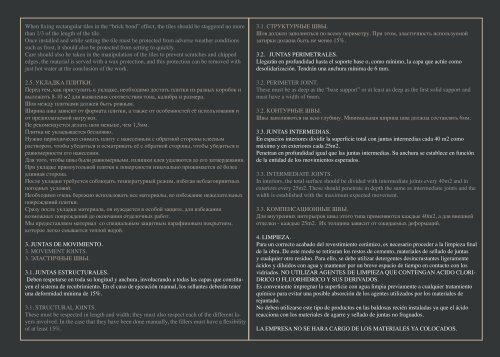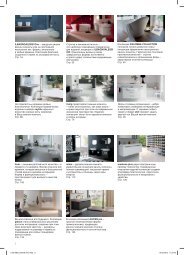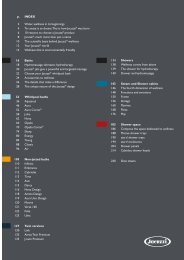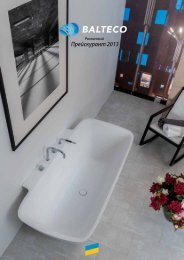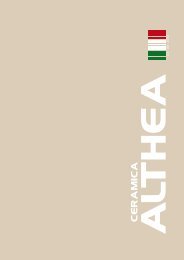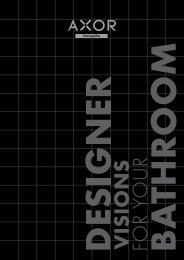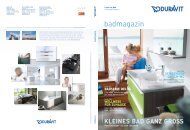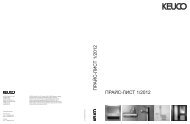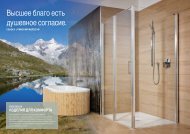Bestile Maderas
You also want an ePaper? Increase the reach of your titles
YUMPU automatically turns print PDFs into web optimized ePapers that Google loves.
When fixing rectangular tiles in the “brick bond” effect, the tiles should be staggered no more<br />
than 1/3 of the length of the tile.<br />
Once installed and while setting the tile must be protected from adverse weather conditions<br />
such as frost, it should also be protected from setting to quickly.<br />
Care should also be taken in the manipulation of the tiles to prevent scratches and chipped<br />
edges, the material is served with a wax protection, and this protection can be removed with<br />
just hot water at the conclusion of the work.<br />
2.5. УКЛАДКА ПЛИТКИ.<br />
Перед тем, как приступить к укладке, необходимо достать плитки из разных коробок и<br />
выложить 8-10 м2 для выявления соответствия тона, калибра и размера.<br />
Шов между плитками должен быть ровным.<br />
Ширина шва зависит от формата плитки, а также от особенностей её использования и<br />
от предполагаемой нагрузки.<br />
Не рекомендуется делать шов меньше, чем 1,5мм.<br />
Плитка не укладывается бесшовно.<br />
Нужно периодически снимать плиту с нанесенным с обратной стороны клеевым<br />
раствором, чтобы убедиться и осматривать её с обратной стороны, чтобы убедиться в<br />
равномерности его нанесения.<br />
Для того, чтобы швы были равномерными, излишки клея удаляются до его затвердевания.<br />
При укладке прямоугольной плитки к поверхности изначально прижимается её более<br />
длинная сторона.<br />
После укладки требуется соблюдать температурный режим, избегая неблагоприятных<br />
погодных условий.<br />
Необходимо очень бережно использовать все материалы, во избежание нежелательных<br />
повреждений плитки.<br />
Сразу после укладки материала, он нуждается в особой защите, для избежания<br />
возможных повреждений до окончания отделочных работ.<br />
Мы предоставляем материал со специальным защитным парафиновым покрытием,<br />
которое легко смывается теплой водой.<br />
3. JUNTAS DE MOVIMIENTO.<br />
3. MOVEMENT JOINTS.<br />
3. ЭЛАСТИЧНЫЕ ШВЫ.<br />
3.1. JUNTAS ESTRUCTURALES.<br />
Deben respetarse en toda su longitud y anchura, involucrando a todas las capas que constituyen<br />
el sistema de recubrimiento. En el caso de ejecución manual, los sellantes deberán tener<br />
una deformidad mínima de 15%.<br />
3.1. STRUCTURAL JOINTS.<br />
These must be respected in length and width; they must also respect each of the different layers<br />
involved. In the case that they have been done manually, the fillers must have a flexibility<br />
of at least 15%.<br />
3.1. СТРУКТУРНЫЕ ШВЫ.<br />
Шов должен заполняться по всему периметру. При этом, эластичность используемой<br />
затирки должна быть не менее 15%.<br />
3.2. JUNTAS PERIMETRALES.<br />
Llegarán en profundidad hasta el soporte base o, como mínimo, la capa que actúe como<br />
desolidarización. Tendrán una anchura mínima de 6 mm.<br />
3.2. PERIMETER JOINT.<br />
These must be as deep as the “base support” or at least as deep as the first solid support and<br />
must have a width of 6mm.<br />
3.2. КОНТУРНЫЕ ШВЫ.<br />
Швы заполняются на всю глубину. Минимальная ширина шва должна составлять 6мм.<br />
3.3. JUNTAS INTERMEDIAS.<br />
En espacios interiores dividir la superficie total con juntas intermedias cada 40 m2 como<br />
máximo y en exteriores cada 25m2.<br />
Penetran en profundidad igual que las juntas intermedias. Su anchura se establece en función<br />
de la entidad de los movimientos esperados.<br />
3.3. INTERMEDIATE JOINTS.<br />
In interiors, the total surface should be divided with intermediate joints every 40m2 and in<br />
exteriors every 25m2. These should penetrate in depth the same as intermediate joints and the<br />
width is established with the maximum expected movement.<br />
3.3. КОМПЕНСАЦИОННЫЕ ШВЫ.<br />
Для внутренних интерьеров швы этого типа применяются каждые 40m2, а для внешней<br />
отделки - каждые 25m2. Их толщина зависит от ожидаемых деформаций.<br />
4. LIMPIEZA.<br />
Para un correcto acabado del revestimiento cerámico, es necesario proceder a la limpieza final<br />
de la obra. De este modo se retiraran los restos de cemento, materiales de sellado de juntas<br />
y cualquier otro residuo. Para ello, se debe utilizar detergentes desincrustantes ligeramente<br />
ácidos y diluidos con agua y mantener por un breve espacio de tiempo en contacto con los<br />
vidriados. NO UTILIZAR AGENTES DE LIMPIEZA QUE CONTENGAN ACIDO CLORI-<br />
DRICO O FLUORHIDRICO Y SUS DERIVADOS.<br />
Es conveniente impregnar la superficie con agua limpia previamente a cualquier tratamiento<br />
químico para evitar una posible absorción de los agentes utilizados por los materiales de<br />
rejuntado.<br />
No deben utilizarse este tipo de productos en las baldosas recién instaladas ya que el ácido<br />
reacciona con los materiales de agarre y sellado de juntas no fraguados.<br />
LA EMPRESA NO SE HARA CARGO DE LOS MATERIALES YA COLOCADOS.<br />
Para facilitar la limpieza y buen uso de nuestros materiales recomendamos el uso de felpudos<br />
en las entradas y es aconsejable mantener el pavimento lo más limpio posible para obtener<br />
buenos resultados.<br />
No se admitirán reclamaciones de problemas derivados del incumplimiento de estas premisas<br />
cuando el material ya esta colocado.<br />
4. CLEANING.<br />
For the correct installation of the tile it is necessary to proceed with the correct cleaning,<br />
at the end of the fixing of the tile. It is important to remove the remainders of the cements,<br />
adhesives and grouts with the adequate removing agent. It is important to use a slight acid<br />
based detergent diluted with water and maintain in contact with the tile as briefly as possible.<br />
NEVER USE CLEANING AGENTS OR DERIVATIVES THAT CONTAIN HYDROCHLO-<br />
RIC OR HYDROFLUORIC ACID.<br />
We advise that before cleaning with any type of chemical based cleaner you should impregnate<br />
the whole area with plenty of water to avoid the possible absorption via the grouting<br />
materials.<br />
It is not advised the use of chemical based cleaners on areas that have been recently installed<br />
as they may create a reaction between the grouted areas and/or the adhesives.<br />
THE COMPANY WILL NOT BE HELD RESPONSIBLE FOR INSTALLED MATERIALS.<br />
WE DO NOT HOLD RESPONSIBILITY FOR THE USE OF FLOOR TILES IN PLACES<br />
DIFFERENT TO THOSE RECOMMENDED OR FOR THE INCORRECT USE OF RAPID<br />
SETTING ADHESIVES.<br />
4.ЭКСПЛУАТАЦИЯ И УХОД.<br />
Для завершения правильной укладки нужно произвести очистку облицовочной<br />
поверхности. Нужно удалить излишки цемента, раствора для затирки швов и т.п. Для<br />
этого необходимо использовать специальные растворители, слабо разведённые водой.<br />
НЕ ИСПОЛЬЗОВАТЬ МОЮЩИЕ СРЕДСТВА НА КИСЛОТНОЙ ОСНОВЕ.<br />
Перед использованием любого химического вещества необходимо смочить поверхность,<br />
для избежания возможной абсорбции веществ, используемых при затирке.<br />
Не использовать данный тип продуктов на только что выложенных плитках, так как<br />
кислота взаимодействует с ещё не застывшими клеем и раствором для затирки.<br />
ФАБРИКА НЕ НЕСЁТ ОТВЕТСВЕННОСТИ ЗА МАТЕРИАЛЫ, ПОБЫВАВШИЕ В<br />
ЭКСПЛУАТАЦИИ.<br />
Для увеличения срока службы выклеенного материала в помещении необходимо<br />
положить коврик, а также, содержать поверхность пола в максимально чистом<br />
состоянии.<br />
Не принимаются претензии при несоблюдении вышеперечисленных условий<br />
эксплуатации.<br />
FORMAS DE COLOCACIÓN · DIFFERENT WAYS OF TILING · LES FACONS DE POSE ·<br />
VERLEGUNGSARTEN


